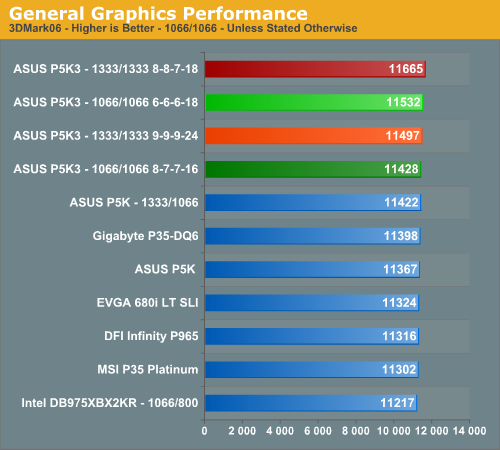Synthetic Graphics Performance
The 3DMark series of benchmarks developed and provided by Futuremark are among the most widely used tools for benchmark reporting and comparisons. Although the benchmarks are very useful for providing apples-to-apples comparisons across a broad array of GPU and CPU configurations they are not a substitute for actual application and gaming benchmarks. In this sense we consider the 3DMark benchmarks to be purely synthetic in nature but still very valuable for providing consistent measurements of performance.

The updated BIOS and memory timings improve the DDR3 scores slightly in both Futuremark benchmarks, but the scores are still tightly clustered. Particularly in 3DMark06, the GPU is generally the bottleneck except for the SM3.0 tests, but we do see minor improvements with the 8-8-7 DDR3-1333 and 6-6-6 DDR3-1066 settings regardless.
Quick Take
There are no real surprises in our memory testing today except for the 11% improvement in the S.T.A.L.K.E.R. DDR3-1066 score with 6-6-6-18 timings. Overall, the performance improvements of moving to lower memory timings were around 1%~2% on average. Not bad, considering our memory sub-timings had to be significantly relaxed in some cases to run at the lower timings on stock voltages. We were hoping for more but it is obvious after running some initial benchmarks that we need to spend more time tweaking and tuning the 0411 BIOS that ASUS provided today. Besides offering 1T command rates, this BIOS will allow up to DDR3-2200 speeds if you have memory that will do it. Expect to hear more from us shortly on this BIOS release and additional ones received from Gigabyte and MSI.We are still trying to find the right balance of settings/voltages with our Corsair DDR3 modules on two other DDR3 motherboards. We thought we had stumbled upon the right mix of speed, latencies, and timings yesterday, but with BIOS of the day releases from the manufacturers at this point, it is difficult to setup a board properly without having the next BIOS appearing in your mailbox. We are not complaining, far from it, considering the dearth of BIOS releases during the initial P965 launch activities. We are greatly pleased with the manufacturers at this point in their ability to address problems and improve performance on an almost daily basis.
Unfortunately, we do not have new video card drivers so our results today mirror those of our P35 CrossFire preview article last week. The performance differences between our DDR2 and DDR3 boards mirrored our single GPU results. While the P35 was not designed specifically with CrossFire in mind, it does possess this capability. As such, we are still hoping that AMD can tune their R600 drivers properly in a reasonable amount of time to improve CrossFire performance on the Intel chipsets.
Considering the performance of the P35 chipset when set up correctly, we would love to see a manufacturer utilize a different PCIe controller chip setup and bring 8x8 CrossFire capability to this chipset. If abit or DFI is listening, please take a run at it as this type of engineering is something you excelled at previously. If not, we anxiously await the new X38 chipset even though the 975X obviously still has a lot of life left in it.
Overall, we still have a lot P35 motherboard testing left to complete and then we'll be reporting the results to you. We've only scratched the surface when it comes to overclocking and improving memory performance on our boards. Of course this is only one area of interest and we also have some significant storage subsystem testing to complete on the new ICH9 along with revised network/audio benchmarks for Vista. With Barcelona/Agena on the horizon, this is shaping up to be one very busy and exciting summer.










13 Comments
View All Comments
vailr - Wednesday, May 23, 2007 - link
In your upcoming P35 review, please include a rundown of AHCI mode.Including such items as:
1. Hot-swap capability of single drives, comparing
AHCI on Intel v. JMicron SATA port.
2. Hot-swap on Raid 1 array.
3. Details of setting up a fresh Windows XP and/or Windows Vista install, when AHCI is enabled in bios. F6 floppy driver install v. slipstreaming drivers into installation CD.
4. Speed comparison of: A. AHCI enabled v. disabled B. Intel SATA v. JMicron SATA.
5. Identifying "AHCI-capable" hard drives, v. older ("SATA 150", etc.) hard drives.
gigahertz20 - Wednesday, May 23, 2007 - link
Last page of this article called "Quick Take" is not loading with IE7. -May 23rd, 9:21PM EasternJarredWalton - Wednesday, May 23, 2007 - link
Corrected. The Quick Take is on the same page as the Futuremark scores, and there was just an extra link at the end.